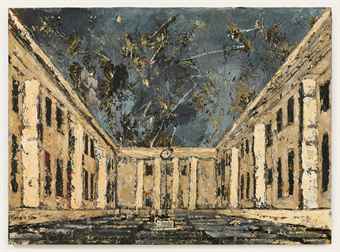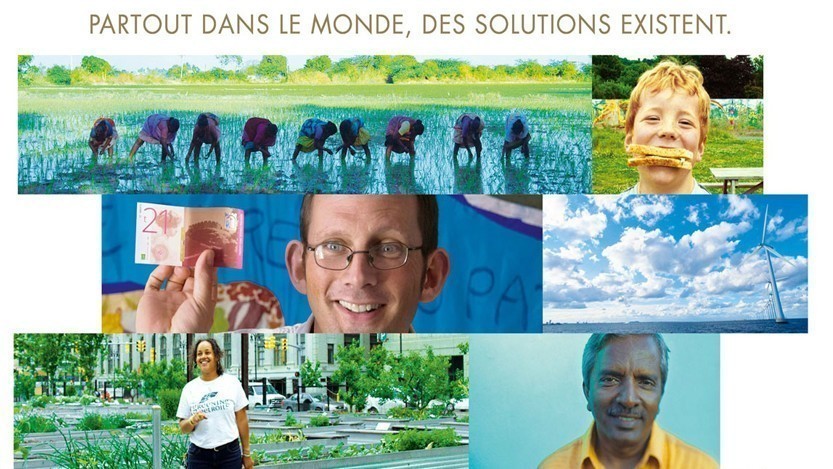 |
| Anselm Kiefer, Pour Paul Celan: Fleur de cendre, 2006 |
I have followed Anselm Kiefer’s work since
the early 1980s and, having seen it many times in exhibition, wondered if there
was anything new to see in the retrospective at the Centre Pompidou. It is
called a “retrospective,” a title that immediately piqued my curiosity: how can
the monumental works of this prolific artist be brought together in one place?
How could the vastness of Kiefer’s oeuvre be given comprehension and coherence in
the relatively compact space of half of level six? For all these reasons, I decided
to take a friend who is not familiar with Kiefer’s work, and whose intellectual
life is devoted to French literature and culture. Kiefer’s work is so
resolutely German, and for the most part, impenetrable. How would it appear to
strangers?
 |
| Anselm Kiefer, Nothung, 1973 |
Given all the constraints generated by the
size and proliferation of Kiefer’s canvases and installations, I have to say,
the selection and exhibition of the works did give a good overview of his approaches,
aesthetic and thematic concerns. Of course, none of the big installations are
included, but what makes this exhibition unique is the centrality given to the
monumental paintings from the 1970s and 80s. Many of these, such as Nothung (1973) or Shulamith (1983) are more difficult to access, because they are dark,
often filled with decay, cindered remains that are dense with reference to
German history, philosophical discourse and layer upon layer of cultural
reference. Thus, their placement as key developmental works is a courageous and
welcome decision on the part of the Pompidou. I was also impressed with the
choice of works, many of them never having been exhibited in France. At least,
I had not seen a lot of them. In fact, despite having followed Kiefer’s work
for over thirty years, about 70% of them I was seeing in the flesh for the
first time. For example, one room is devoted to Kiefer’s Vitrines which were intriguing and hauntingly beautiful. Even
though they engage many similar themes to those of the monumental paintings, the
vitrines are unique. Aesthetically, their mélange of lead, glass, dust and
poetry places them closer to the books than the monumental paintings in the
exhibition.
 |
| Anselm Kiefer, Palette on a Rope, 1977 |
Kiefer’s artistic language is difficult,
and I would have thought this were especially so for a French audience. His
work represents a constant search for a language with which to understand and
integrate the unfathomable complexity of German history into the present. A lot
of the time, Kiefer does this through reflection on his own role within that
history, within the depiction of that history. Some of his early attempts caused
a ruckus in Germany. At a time when silence prevailed around the Holocaust and
the presence of Nazi Germany in everyday German life was at best ignored,
Kiefer took photographs and painted himself performing Heil Hitler salutes on
beaches. In one of my favourite works, Palette
on a Rope (1977), an otherwise abstract grey palette is suspended between
two cords. The simplicity of Palette on a
Rope makes it powerful, an image in which he reduces the discourse on
history, memory, representation, far off lands and inexplicable dilemmas to an
artist’s palette in grey. This is, of course, Kiefer’s way of making sense of
all that he paints: through his eyes as an artist.
 |
Anselm Kiefer, Nothung, 1973
|
I was interested in my friend Loren’s response,
as someone schooled in French thought, before a body of work, so resolutely
German. He saw it is as a kind of writing, a furious attempt to communicate to
the point where it becomes like graffiti, scribbling and scrawling, defacing
and revising the history. This is, as he pointed out, what saves Kiefer from
the accusation of grandiosity, and a sense of his own importance--he sometimes
equates the artist with God--to understanding the depths of history. All of
Kiefer’s canvases and are steeped in irony, an irony that takes many different
forms. There are moments when we suspect he is being the self-conscious
provocateur. At others, he lets slip an uncertainty of his own centrality, his
own grasp on what he represents. It’s not only in the uneven textures, the
burning of his own and other’s work, the erasure of his images. But also, irony
pervades the depth and richness of the references, the complexity of materials
that are always charged with a significance that enables them to articulate
beyond their materiality. Added to this, the paintings are like visual events
that are the equivalent of a Paul Celan poem in which there is no structure, no
language which could possibly articulate the depth and complexity of what he is
already representing. It is, ultimately, the only way Kiefer dares to paint something
that cannot be painted.
As I say, Kiefer often puts the painter at
the centre of these vast universes, but the painter is always anonymous,
equated with the unknown soldier, a nobody. In To the Unknown Painter (1983)
the mausoleum is built for the painter as God, equated with Hitler through
its architecture and an unknown soldier, the symbolic death for a nation’s
loss. As always, the tomb (of the painter) is surrounded by death, fire, and
skies heavy with lead. The corrosion of the textured canvas becomes the image
of German history, dried up, burnt, never to rise again.
 |
| Anselm Kiefer, Etroits sont les vaisseaux, 2002 |
I also wondered for the first time, do we
really need to know the references to history, to legend, to the Nazis in order
to access Kiefer’s work? Doesn’t this painting with its black, ashen decay,
show everything it needs to, visually? Even though the paintings simultaneously
are not always asking to be seen, but rather, they become like philosophical dramas
asking to be read.
Our conversation about the landscapes brought
new insights. We discussed the landscapes as an invitation to go on a journey,
to trudge across dirty snow scattered with books, lead books, burnt books, to a
distant horizon that, for Kiefer, always promises through a ray of hope. The
books are burnt, books are stepping stones on a journey, they are placemarks in
history as well as the detritus of that same history, they represent a knowledge
that is now out of date. And the books are usually written by men. They scatter
these landscapes, just as the official versions of history, but with
characteristic Kiefer irony, the books are the litter that make this land a
repository for the rubbish of history. And it goes on: books deface the canvas
to show that this is just a story, a story that can be rewritten, trashed, once
again, ensuring that Kiefer’s repeated message is clear: I do not claim to have
the last say about this history that I paint.













